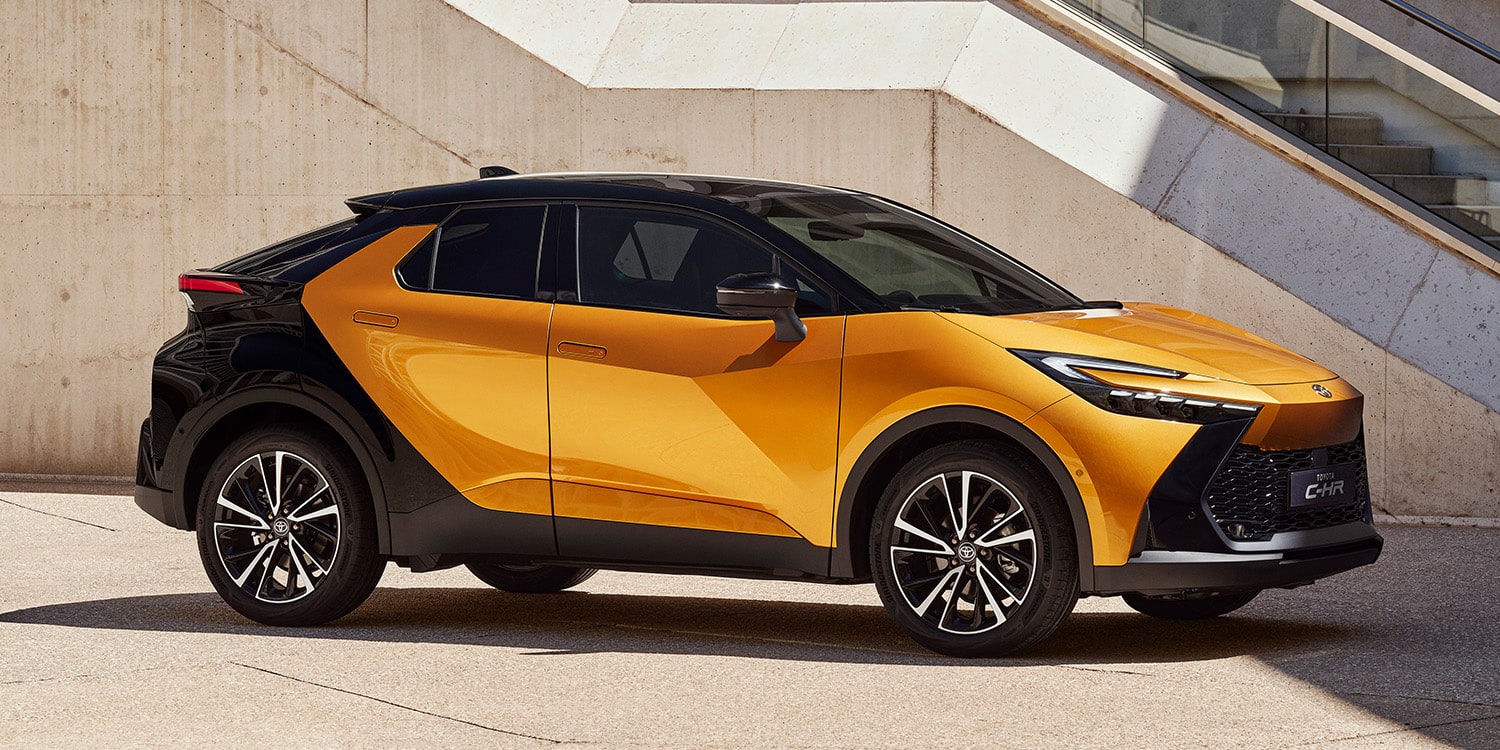Toyota has introduced the second generation of its C-HR coupé-like SUV model, now offering it as a plug-in hybrid (PHEV) alongside three full hybrid versions. The new models feature Toyota’s fifth-generation hybrid powertrain, which has undergone a significant redesign to reduce size and weight while increasing power. The C-HR PHEV boasts a system power of 223 hp and an all-electric range of 66 kilometres.
Plug-In Hybrid
The plug-in hybrid variant of the C-HR utilizes the same drivetrain that Toyota introduced in the fifth generation of the Prius in November 2022. It combines a 111 kW 2.0-litre petrol engine with a 120 kW/160 hp transaxle electric motor on the front axle, housed within a single casing along with the electric motor, planetary gearbox, and differential, creating a front-wheel drive system.

Toyota claims the C-HR plug-in hybrid delivers a “one-pedal” driving experience. It offers three levels of recuperation, which enhance driving in city traffic by allowing drivers to control deceleration and recharging. The system automatically adjusts the driving mode to optimize energy efficiency and identifies optimal recharge opportunities based on the vehicle’s navigation system. Additionally, the vehicle features a geofencing function that automatically lets it switch to EV mode when entering an environmental zone.
PHEV
Apart from the PHEV variant with a 2.0-litre petrol engine, the C-HR is also available in full hybrid versions with 1.8-litre and 2.0-litre displacements. The 2.0-litre hybrid model can be equipped with an additional electric motor on the rear axle, creating an all-wheel-drive system known as AWD-i.
The second-generation C-HR incorporates the design elements from the CH-R Prologue concept presented in late 2022. The standard model has dimensions of 4.36 meters in length, 1.83 meters in width, and 1.57 meters in height. The C-HR plug-in hybrid can accelerate from 0 to 100 km/h in 7.3 seconds, with a 180 km/h top speed. However, the announcement does not provide information on the availability or pricing of the C-HR or the PHEV variant.
Pros of the Toyota C-HR Second Generation:
-
Plug-in Hybrid Option: Adding a plug-in hybrid variant increases fuel efficiency and reduces emissions, making it a more environmentally friendly choice than traditional gasoline-only vehicles.
-
Improved Powertrain: The fifth-generation hybrid powertrain offers more power while being smaller and lighter, resulting in better performance and efficiency.
-
All-Electric Range: The plug-in hybrid version offers an all-electric range of 66 kilometres, allowing for shorter daily commutes or trips to be completed solely on electric power.
-
“One-Pedal” Driving Experience: The C-HR PHEV provides a one-pedal driving experience, allowing for convenient deceleration and recharging, which is particularly useful in city traffic conditions.
-
Adaptive Driving Mode: The system automatically adjusts the driving mode to optimize energy efficiency, enhancing the overall performance and driving experience.
-
Geofencing Function: The geofencing feature automatically switches the vehicle to EV mode when entering environmental zones, contributing to reduced emissions and compliance with local regulations.
-
Stylish Design: The C-HR’s coupé-like SUV design, inspired by the CH-R Prologue concept, offers a distinctive and eye-catching appearance.
Cons of the Toyota C-HR Second Generation:
-
Limited Availability: The announcement does not specify the availability or launch date of the C-HR second generation or its pricing, making it difficult to plan for potential buyers.
-
Limited Electric Range: While the plug-in hybrid variant offers an all-electric range of 66 kilometres, it may still be limited for longer trips or those with limited access to charging infrastructure.
-
Potential Price Premium: Plug-in hybrid vehicles often have a higher price tag than their non-hybrid counterparts. The pricing details for the C-HR PHEV are not provided, so it remains to be seen how competitive it will be.
-
Space and Utility Trade-Off: The coupé-like design of the C-HR may compromise rear headroom and cargo space compared to traditional SUVs, limiting its practicality for passengers or those requiring ample storage capacity.
-
Limited Rear Electric Motor Availability: The option for an additional electric motor on the rear axle, creating an all-wheel-drive system, is only available with the 2.0-litre hybrid version, restricting the choice for customers who prefer all-wheel drive in the PHEV variant.
-
Lack of Specific Technical Details: The announcement lacks detailed technical specifications, such as battery capacity, charging times, and additional features, which would provide a more comprehensive understanding of the vehicle’s capabilities and performance.
Conclusion
The second generation of the Toyota C-HR presents several notable advantages. Introducing a plug-in hybrid variant offers improved fuel efficiency, reduced emissions, and an all-electric range of 66 kilometres.
The fifth-generation hybrid powertrain brings more power while being smaller and lighter, enhancing performance and efficiency. Features like the “one-pedal” driving experience, adaptive driving mode, and geofencing function contribute to a convenient and eco-friendly driving experience. The stylish design inspired by the CH-R Prologue concept adds to its appeal.
However, some limitations should be considered. The availability and pricing of the C-HR second generation, particularly the plug-in hybrid variant, are not specified, making it challenging for potential buyers to plan accordingly.
All electric
The all-electric range may be limited for longer trips or areas with limited charging infrastructure. The coupé-like design could impact rear headroom and cargo space, compromising practicality for sure passengers or those needing ample storage. Additionally, the announcement’s lack of specific technical details leaves some questions unanswered.
The second-generation Toyota C-HR shows promise as an environmentally friendly and stylish SUV option. As more comprehensive information becomes available, potential buyers can make a more informed decision based on their specific needs and preferences.





































